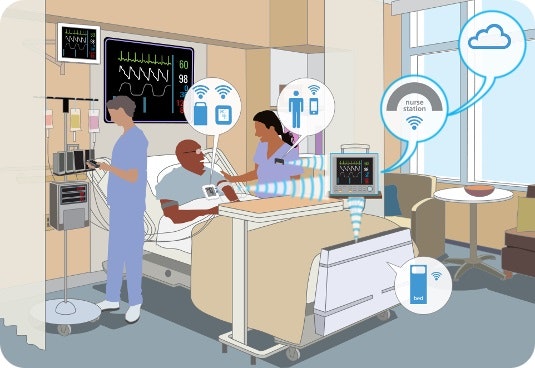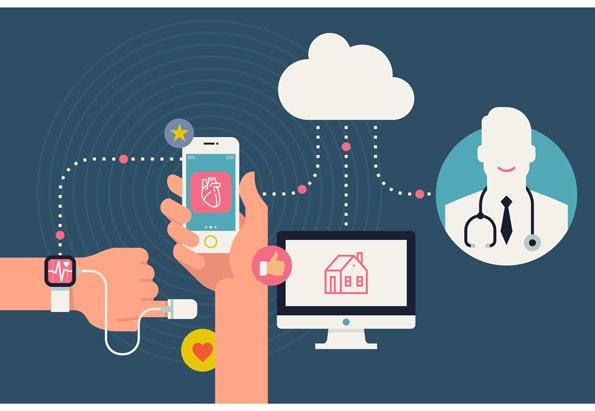How Small Practices Should Think About IoT
The Internet of Things (IoT) is rapidly transforming the medical industry by redefining how people, devices and applications connect and interact with each other. These revolutionary new interactions are allowing medical practices of all sizes to deliver innovative health care solutions.
Applying IoT in the medical world comes with numerous benefits that are associated with aspects—critical care response, preventative care etc. And as medical practitioners happily embrace the advantages of technology, it becomes important for medical device manufacturers to further explore the possibilities of innovation and establish themselves in this new era of the connected medical industry.
Seeing how these two sides of a vast industry can cooperate with each other on the implementation of IoT is no easy feat.
In this article, we’ll help you understand the growing importance and role of IoT in the health care industry—with analysis from an industry insider.
Here’s what we’ll cover:
Defining IoT for Small Practices
IoT Adoption Trends in the Medical Industry
Looking Ahead: Medical IoT Benefits
Defining IoT for Small Practices
IoT offers tremendous business opportunities for medical practices of all sizes. But to understand more about the prospects and scope of IoT at small practices, we spoke with an expert:

Waqaas Al-Siddiq, chairman, CEO and founder of Biotricity
As the CEO of Biotricity, Al-Siddiq is at the forefront of the focus on improving health care through technology. He notes that, from a small practice perspective, there are two key components of IoT—its internal component and its external component. He lays them out as follows:
Internal: How IoT solutions streamline business.
“The _first [key component] is internal to the practice, and that means utilizing solutions that can increase efficiency, save time and bring in automation with minimal IT overhead. IT overhead is a big issue for small practices and that is why IoT implementation at this level will require seamless solutions where the practice is indirectly consuming IoT.”_
-Waqaas Al-Siddiq, chairman, CEO and founder, Biotricity
External: How IoT improves the patience experience.
“The _second [key component] is leveraging IoT-based solutions that can be delivered to the patient. IoT-based solutions that can collect data, provide routine reminders and feedback and summarize data for the next in-person visit will be game changers for small practices. Such solutions would not only increase the efficiency of routine and follow-up visits, but also provide better insight into the patient and improve outcomes.”_
-Waqaas Al-Siddiq, chairman, CEO and founder, Biotricity
Here’s the most important point to remember as a small practice:
At your scale, your consumption of IoT-related technologies will be related to buying connected devices to help you manage patient data.
“The scope for IoT in small practices will be more secondary in nature, as opposed to direct consumption of IoT,” Al-Siddiq says.
“For example, physician practices will end up buying more connected devices, as they will help streamline their internal workflow. As devices become connected, they will upload their data directly into the EMR, as opposed to having a physician or a physician’s assistant manually enter such information.”

Connected devices in a medical practice (Source: Lairdtech.com)
Such a system of connected devices will help you save useful time for your small medical practice and also streamline the practice by making it more efficient.
IoT Adoption Trends in the Medical Industry
IoT is not just an interesting bit of technology, but a real business opportunity for many health care organizations. Its high adoption rate is a testament to its rightful growth.
According to a recent survey by Hewlett Packard subsidiary Aruba, 87 percent of health care organizations will adopt IoT technologies by the end of 2019.
Currently, 60 percent of health care organizations have already integrated these technologies with their infrastructure—the third-highest adoption rate among all industries.
The most common areas where these technologies are being utilized are patient monitoring and maintenance followed by remote operation and control. Check out the below video by Aruba that talks about the adoption trends and overall process of patient care using health care-related IoT:
Improving patient care through IoT in healthcare (Source: YouTube.com)
In addition, Gartner forecasts that there will be 8.4 billion connected devices in use worldwide in 2017, a 31 percent increase over 2016’s total. This number is predicted to reach 20.4 billion by 2020. Specifically in the health care industry, real-time location devices would be the driving factor.
It’s easy to note that IoT offers a promising future to the medical world and is here to stay. It’s still in the evolutionary stage and will take some time before health care organizations fully adopt this technology.
IoT Medical Devices in Action
Long before IoT gathered attention in the medical field, the industry was already doing remote gathering of data through telemetry.
At a basic level, IoT works on the concept that anything that can be linked to a sensor is capable of communicating data to a receiver.
But IoT is not only about collecting and viewing data—it’s applications are much more involved in the world of internet and providing value to all stakeholders.
There are several applications of IoT in the medical industry. Some of them are:
Real-time location services: Using IoT, physicians are able to use real-time location services to track connected devices that are used to treat patients. Doctors and other medical staff can easily track sensor-enabled devices (such as pumps, wheelchairs etc.) that either get misplaced or become out-of-sight.
Patient and environment monitoring: Doctors and clinicians can predict the arrival of patients in critical care units through the use of IoT. They can also remotely track and monitor patient status in real time.

Remote health monitoring (Source: Electronic Design)
Check on hygiene levels: IoT enables physicians and doctors monitor the degree of cleanliness among the medical staff members. For example, a device starts buzzing whenever a staff member with dirty hands comes near a patient’s bed. This helps them save patients from infections that might be present in the medical practice.
Regarding the useful IoT applications for small medical practitioners, Al-Siddiq mentioned, “I think the most useful IoT applications will be connected medical devices and analysis tools that can automate data entry and perform simple summaries.”
“Devices like spirometers, blood pressure monitors, ECG machines, pulse oximeters, basic blood analysis and other such devices will become very useful from a general practice perspective” says Al-Siddiq.
He adds that, “chronic care management solutions for ‘outside practice use’ will also help small practitioners manage patients better by increasing interactivity and making ongoing and follow up visits more productive.”
The applications mentioned above are just a small part of the numerous ways through which IoT can help medical professionals take better care of their patients. The scope for advancement through IoT is unlimited in the medical world.
Looking Ahead: Medical IoT Benefits
Today’s IoT devices are replacing human involvement in decision-making processes at various steps through the use of analytics. This means that connected health care has become a reality. This offers several benefits to small medical practices, such as:
Reduced costs: Through IoT, patient monitoring is carried out in real time that reduces unnecessary doctor and patient visits.
Fewer errors: Automated workflow and accurate data collection result in minimum errors.
Better patient experience: Patient needs are addressed efficiently through connected health care devices. Enhanced accuracy and proactive diagnosis adds to the trust factor among patients.
When asked about how solo doctors and small medical practitioners could leverage the benefits of IoT, Al-Siddiq suggested “to focus on leveraging IoT by purchasing solutions that encompass such technologies without introducing IT overhead.”
Small practices should “focus on solutions that are automated, have limited setup time, and ultimately save time and improve internal workflow.” But beware of one caveat—small medical practices are the most vulnerable to cyber attacks, so security is paramount.
Much of our advice has centered around the implementation and use of health IT. If you are a small medical practice searching for the right medical software, check out the below listed resources:
Compare vendor pricing, screenshots and reviews on our site
Download our Medical Software Buyer’s Toolkit
Or, you can fill this short questionnaire to receive custom price quotes of different medical software delivered to your inbox.